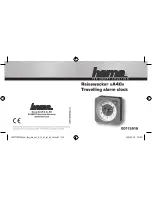
©
AirSense Technology Ltd. 2005
Page 8
Stratos-Micra 100
• INSTALLER’S HANDBOOK • Iss. 3
3.1 Time and date –
Time and Date
tab
It is important that the time and date be set up correctly on the controller’s internal cal-
endar/clock because it uses this information to store events in the event log. See sec-
tion 8, “Event log” for more details. Unless specially ordered, units are supplied with
the correct setting for UK time. This is backed up with a rechargeable battery. Later
adjustments to the clock setting should not exceed ± 70 minutes unless a FastLearn is
initiated
3.2 Alarm levels -
Alarm levels and delays
tab,
Level
subgroup
The value set in the
Fire
,
Pre-Alarm
and
Aux
functions in the
Level
subgroup is
the relatively scaled bargraph level at which the appropriate alarm is initiated on the
detector. The
Fire 2
level assigns an absolutely scaled alarm level in % obs/m.
The
Aux
level is set by factory default at level 10 which means that this alarm will occur
after the
Fire
alarm. The default level settings for Pre-Alarm and Fire 1 are 6 and 8
respectively. The default setting for Fire 2 is 20% obs/m.
3.3 Alarm delays -
Alarm levels and delays
tab,
Delay
subgroup
The alarm delay is the number of seconds that an alarm level has to be continuously
sensed before the alarm is initiated. Each alarm level has a programmable delay of
between 0 and 90 seconds. The default delay for each alarm level is 5 seconds.
3.4 ClassiFire
®
override -
Alarm levels and delays
tab
This function has no current use on the Stratos-Micra 100 but is reserved for future expan-
sion purposes.
3.5 Alarm factor -
Alarm levels and delays
tab
The detector sensitivity is set with this entry, which will also affect the probability of nui-
sance alarms. 0 = high sensitivity, higher probability, 8 = low sensitivity, lower proba-
bility. The default alarm factor is 4.
Note:
The highest sensitivity setting is suitable for clean, environmentally controlled envi-
ronments, e.g. semiconductor manufacturing clean rooms where airborne pollutants are
kept to an absolute minimum and the least contamination is cause for alarm.
Use of this setting in a busy machine shop would lead to relatively frequent nuisance alarms
due to the normal variation of atmospheric contamination and a lower sensitivity setting is
recommended.
It is therefore important that the alarm factor chosen is suitable for the
area to be protected.
When the appropriate alarm factor for the protected area has been
set, nuisance alarms will be reduced to an absolute minimum.
WWW.UKPANELS.COM









































